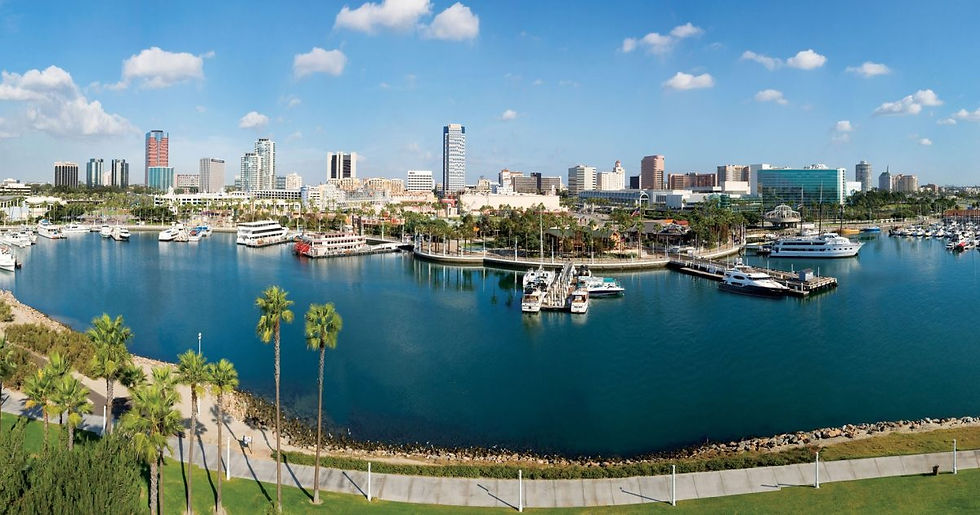Long Beach Water Quality Assessment- What Home Owners Should Know
- Hague

- Oct 22
- 3 min read

(And How You Can Upgrade to Cleaner, Softer Water)
If you're a Long Beach resident and have experienced unusual tastes in your drinking water, white deposits on faucets, or dry hair and skin after showers, you're noticing genuine water issues. With over thirty years of experience in Southern California, we have observed that even when municipal systems "meet standards," home water conditions can still improve with treatment. Let's explore Long Beach water quality and what actions you can take.

Where Long Beach’s Water Comes From
The Long Beach Utilities Department (LBUD) states that approximately 60% of the city's drinking water comes from local groundwater sources, while the remaining ~40% is imported from regional surface water supplies. As a result, the water in your home may have different mineral content based on your neighborhood and the water source.
Additionally, the city conducts tens of thousands of tests annually, utilizing state-certified laboratories and releasing comprehensive yearly reports that demonstrate adherence to state and federal drinking-water standards.
What We See in Long Beach Homes:
Hard Water & Mineral Build-Up
Many homes in Long Beach receive water that is "moderately hard," containing higher levels of calcium, magnesium, and other minerals. This can lead to scale buildup, cloudy glassware, and reduced appliance lifespan. Although the city complies with regulatory standards, water hardness is more of a "comfort and maintenance" issue than a direct health risk.
Taste, Odor & Disinfection Residuals
Although chlorine and disinfectants are used correctly in Long Beach, you might still detect slight taste or odor issues, especially in hot water or when the water source changes. These aesthetic concerns are important to homeowners and often lead to decisions about filtration.
What the EWG Tap Water Database Reveals
According to the EWG’s database for the Long Beach Utilities Department water system, while the supply meets federal regulatory standards, several contaminants exceed the stricter health-guideline thresholds set by independent researchers. For example:
Arsenic was detected at ~2.75 parts per billion (ppb), well under the legal limit of 10 ppb, but dramatically above EWG’s health guideline of 0.004 ppb.
Several disinfection-byproduct contaminants (e.g., haloacetic acids) are reported — while within legal limits, they exceed EWG’s more conservative health benchmarks, indicating that advanced filtration could reduce long-term exposure risk.
Why Treatment Still Makes Sense
Just because water meets “safe” legal standards doesn’t mean it’s ideal for your home. In older homes with aged plumbing or higher mineral loads, We have seen scale shortening water-heater life, reducing efficiency of dishwashers, and leaving white rings on bathtubs. With our three decades of installs in SoCal cities like Long Beach, I can tell you the savings and comfort upgrade from treatment systems often justify the cost, saving money for the customer in the long run.

How the Right System Helps Long Beach Water Quality
Here are the two key systems we recommend:
Whole-House Conditioning + Filtration
For your Long Beach home, a system like the Hague WaterMax, that handles hardness + taste/odor + scale protection is smart. It protects fixtures, appliances and improves daily comfort (softer showers, cleaner dishes).
Point-of-Use Drinking Water System
Even with great municipal water, an under-sink or RO (reverse osmosis) system like the Hague H3500 delivers premium drinking/cooking water — better taste, fewer contaminants, peace of mind.
Because we have worked with hundreds of installs in the region, we use systems tuned for our specific water profiles (mineral load, source variability, peak conditions and water pressure) and help ensure they’re correctly sized and maintained.

Why It’s a Good Time in Long Beach
With recent system upgrades and water-source variations, now is a good time to assess your home’s plumbing and water quality.
You’ll likely feel the difference quickly — fewer white spots, better soap lather, improved glass clarity, and maybe a drop in maintenance costs.
Schedule a free in-home water test with us and we can pinpoint if your hardness or taste issues are strong enough that treatment is worth it.
What You Should Do Next
Arrange for a No Obligation in-home System Consultation we will come out, test hardness, taste/odor factors, and check your plumbing context.
Review your results: If you’re above ~8–10 grains per gallon, or you’re seeing scale, smell/odor or aesthetic nuisances, it’s worth discussing solutions.
Choose a custom system designed for your home. With our experience, we can help you avoid overpaying and ensure the system delivers durable, effective results.
Maintain it. Even the best system needs proper installation and periodic maintenance — Our technicians are familiar with Long Beach water conditions.
If you’re in Long Beach and you want to feel, taste and see better water — I’m here to help. Contact me at 562-461-0777 or o
n our home page and let’s schedule your free assessment today.




Comments